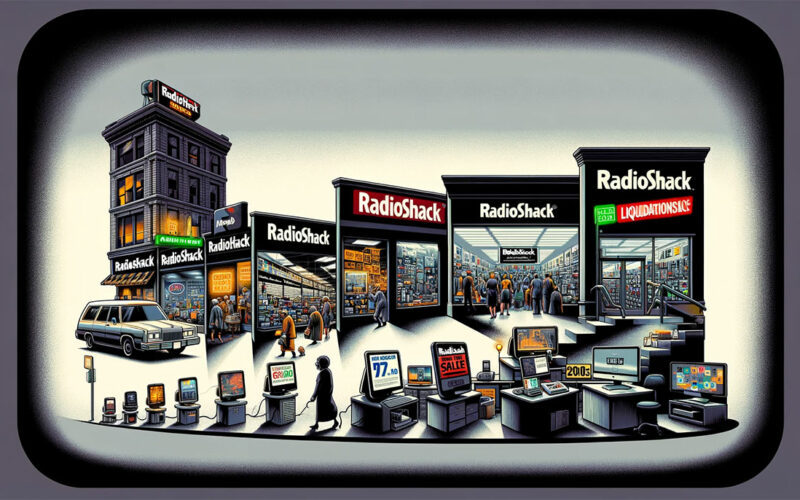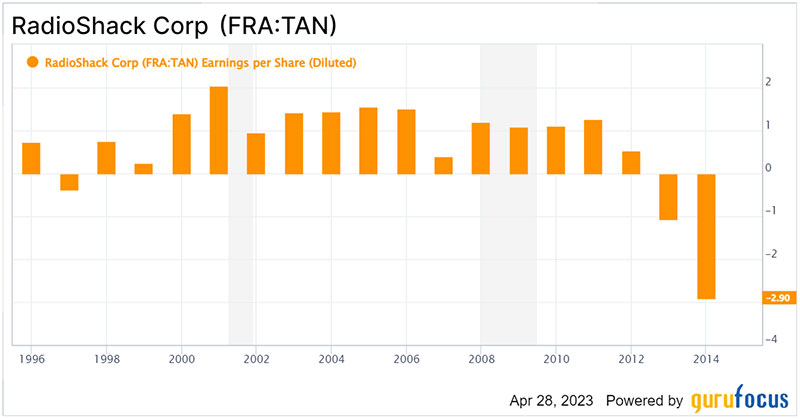Lost Signals: What Happened to RadioShack?

Let’s wind back the clock. Imagine a time when the radio was king, and electronics stores were the gateways to innovation.
That’s where RadioShack danced into the scene, a place where hobbyists and professionals alike flocked to get the newest components that would fuel their dreams. From its founding and early success, this was the go-to spot for anything tech.
But it wasn’t just about selling resistors and radio parts. No, RadioShack had bigger plans.
They soared, becoming the tech leader in the late 20th century, rubbing shoulders with the giants and etching their name in the silicon of history. If you needed a battery or a walkie-talkie, you didn’t Google it, you RadioShacked it!
The shelves were lined with shiny gadgets, and the air buzzed with the chatter of transistor radios and the latest electronic toys.
This was the era of the Tandy computer – RadioShack’s very own. It was a beacon of the times, a symbol that RadioShack wasn’t just playing the tech game; they were ahead of it.
Strategic Missteps
Failure to Adapt to Market Changes
But let’s flip the script. We can’t talk about what happened to RadioShack without diving into the mixtape of mishaps.
First off, the personal computer revolution was like a tsunami, and RadioShack? They missed the boat. While PCs were taking over the world, RadioShack was stuck in the past, fumbling with outdated models.
Then came the rise of e-commerce. Online shopping – a new frontier, and our electronics maestro? Caught napping.
They hit the snooze button one too many times, and before they knew it, digital carts were rolling past their physical stores.
Product and Service Focus
But wait, there’s more to this saga. RadioShack’s bread and butter? Cell phone sales. But when the market got flooded, this strategy started to short-circuit.
They banked on it heavily, and as the tides changed, they found themselves adrift.
And then, there’s the DIY crew and the Maker movement. They were all about circuits and soldering irons, the kind of stuff RadioShack could have rocked in their sleep.
But somehow, they turned a blind eye, missing out on a community that was all about innovation, about making things from scratch. This was a crowd that could’ve been loyal patrons, but they were left asking, “what happened to RadioShack?”
Operational Challenges
Store Concentration and Cannibalization
Imagine strolling through your city. There’s a RadioShack. Turn the corner, another one. It’s like, “Hey, didn’t I just see you?”
That’s right, these stores were popping up faster than dandelions in spring. So many, in fact, it was like they were competing with… themselves. Seriously, internal competition was fierce.
In the retail world, that’s like trying to sing a duet solo. You might think more stores equal more money, right? Not quite.
When your stores start to cannibalize each other’s sales, it’s a bit like sharing your lunch with yourself – it just doesn’t make sense.
Inventory and Space Management
Walk into one of the shops, and it’s a treasure hunt. You’ve got ancient radio parts next to the hottest cell phones.
The inventory mix was all over the map. And good luck finding what you need in a cramped space. It was a bit like fitting a square peg in a round hole, but the peg is a boombox, and the hole is a mailbox.
You’re there, scratching your head, thinking, “what happened to RadioShack?” Well, they were juggling gadgets from different eras in a closet-sized space, trying to hit a moving target while blindfolded.
Financial and Management Turmoil
Management Instability
Flip the scene to their HQ. The big bosses’ chairs must have had some ejector button because leaders were coming and going like it was a game of musical chairs.
Frequent changes in leadership meant RadioShack was always trying to catch its balance, like riding a unicycle on a tightrope during a windstorm.
This wasn’t your average company shuffle – it was a full-on dance-off, but the music kept changing.
Financial Missteps

And the money side of things? Well, if you’ve heard of negative earnings, you know that’s not the kind of negatives you want.
The debt stacked up so high, you’d need a ladder to see over it. They were borrowing cash like it was going out of fashion, but the loan terms? As restrictive as a straightjacket.
When they tried to close stores to save some dough, those loan terms came back like a boomerang. You can’t get out of the hole if you’re not allowed to stop digging. It was a tricky puzzle, like trying to solve a Rubik’s cube with boxing gloves on.
Marketing and Branding Issues
Marketing Confusion
Alright, picture this: RadioShack tries to get hip, slaps on a fresh coat of paint, and suddenly it’s “The Shack.” Sounds cool, right? Except, imagine your Uncle Bob trying to breakdance at a family BBQ – it’s kind of cringe.
This was RadioShack shooting for cool but landing in “huh?” territory. The rebranding efforts missed the mark like a bad haircut. They wanted a new vibe, but customers just scratched their heads, mumbling, “what happened to RadioShack?”
And it wasn’t just the name. The whole brand vibe was like a mixtape with all the genres jumbled. One minute, it’s cell phones, the next, it’s RC cars.
They were spreading themselves thinner than the last squeeze of a toothpaste tube.
Pricing Strategy
Dive into the price tags, and you’d get sticker shock. In a world where every penny counts, RadioShack’s prices had folks clinging to their wallets for dear life. High prices in a bargain-crazy world? Talk about a mismatch. It’s like showing up to a potluck with pricey caviar when everyone just wanted chips and dip.
Competition and Market Evolution
Rise of Online Retailers
Enter the digital gladiators, with Amazon leading the charge. E-commerce came in like a hurricane, and our tech hero was still using a paper map.
The impact of Amazon and the whole online crew had RadioShack looking like a deer in the headlights.
E-commerce platforms didn’t just offer stuff; they offered stuff with convenience. Click, buy, done.
While RadioShack’s customers were still asking, “Do you have this in another store?” the internet answered, “We got you, fam.”
Big Box Retailers
Then there’s the heavyweight bout: RadioShack vs. the big box retailers. Best Buy? Walmart?
They’re like the popular kids in school. They had the muscle to flex big discounts, and their aisles were like electronic wonderlands.
You see, these giants weren’t just selling products; they sold experiences.
While RadioShack was busy figuring out what happened to RadioShack, these retailers were rolling out the red carpet for tech shoppers with sales signs and geek squads.
FAQ On What Happened To Radioshack
Why did RadioShack go out of business?
Well, imagine a juggler, right? RadioShack was juggling tech trends, and they dropped the balls—e-commerce, smartphones, the whole shebang.
They clung to outdated models, and their adaptation skills were like, dial-up in a broadband era. Debt piled up, and their attempts to stay cool?
Kind of flopped—like that “The Shack” rebranding.
What were RadioShack’s biggest mistakes?

First up, missing the personal computer wave—that was a big oops. Then, there’s the e-commerce lag; they hit snooze on that one. And don’t get me started on their fixation on mobile phones when they could’ve diversified.
They also turned a blind eye to tech enthusiasts and hobbyists—the folks who were their bread and butter back in the day.
Did competition affect RadioShack’s decline?
Absolutely, like a game of tech thrones, and RadioShack was outflanked. Best Buy, Walmart, and those online behemoths—you know, Amazon and the gang—they played the game with flash sales and wide selections.
RadioShack tried to play catch-up, but their pricing strategies weren’t just hitting the mark.
Could RadioShack have survived the tech changes?
Survived? Sure. Thrived? That’s the kicker. If they’d surfed the big waves of tech—like really getting the gist of online retail and riding the DIY and Maker movements—they could’ve been a haven for techies.
They needed to adapt and pivot, not just cling to cell phones like a lifeline. But, they missed that boat big time.
What was the role of management in RadioShack’s downfall?
Think of a band with too many lead singers, and none of them agree on the tune. That was RadioShack’s exec team. Leadership changes were frequent, and each new head honcho swayed the ship in a different direction. Consistency was as scarce as a cassette tape in a Spotify world.
Did RadioShack’s store locations contribute to its problems?
Imagine a coffee shop on every block, but they all serve the same brew. That’s RadioShack with their store oversaturation.
They cannibalized their own sales, with more doors open than customers walking in. Their locations needed to be strategic, not just abundant.
How did RadioShack’s inventory management impact their business?
Their inventory was like a grab bag—you never knew what you’d get.
Confusing product mixes, lack of hot-ticket items, and a sprinkle of random gadgets that even the sales folks couldn’t explain. This chaotic inventory just didn’t resonate with what folks wanted or needed.
Was RadioShack’s marketing effective?
Their marketing was kind of like throwing a party and forgetting to send out the invites. They made some rebranding swings—like the whole “The Shack” vibe—but it just didn’t stick.
They needed to nail their brand identity and connect with customers in a way that wasn’t just a shout into the void.
Did RadioShack adapt to the rise of smartphones?
Here’s the irony—they did jump on the smartphone bandwagon but then just wouldn’t get off. They were like that one-hit wonder band that keeps playing the same tune.
Over-reliance on mobile phones made them a one-trick pony when they needed to be a whole circus.
What can other retailers learn from RadioShack’s failure?
It’s like keeping an eye on the weather; you gotta be ready to switch up your strategy when a storm’s brewing.
Diversify, keep pace with tech advancements, and for crying out loud, listen to your customers. Be the place they trust for the latest gear, not the last resort when they can’t find anything else.
Conclusion On What Happened To Radioshack
Let’s break it down, no fluff. When people ask, “what happened to RadioShack?” you gotta look at the whole picture. It’s like they had a map but lost their glasses.
First up, market changes came like a pop quiz, and they were playing hooky that day. Missed tech trends, fumbled e-commerce—it’s like showing up to a game with a tennis racket when everyone else is playing basketball.
They hitched their wagon to cell phones, but that market is a wild bronco, tough to stay on top of. And, oh man, the DIY tech heads and the Maker movement—RadioShack could’ve been their kingdom, but they let that castle crumble.
Talk about an identity crisis with the whole “The Shack” thing. It’s like your grandpa trying to use slang; it just feels off. Their pricing? Sky-high when everyone else was digging for discount gold.
So, the million-dollar question is: what’s the takeaway from the RadioShack saga? Keep your ear to the ground, for real. Trends? Chase ’em. Technology? Embrace it. Your customers? Listen to them like they’re the hottest track. Adaptability is key. You gotta flow like a playlist on shuffle.
Brand identity needs to be more than just a name change. It’s gotta be the soul of your shop. And pricing strategies—don’t play hardball when you’re not in the majors.
Remember, it’s not just about surviving the retail game; it’s about vibing with the times. You see the giants duking it out, the Amazons, the Walmarts? They’re the remix hitting all the right beats.
If you liked this article about what happened to RadioShack, you should check out this article about what happened to Kodak.
There are also similar articles discussing what happened to Saab, what happened to Sports Authority, what happened to Atari, and what happened to Newsweek.
And let’s not forget about articles on what happened to JCPenney, what happened to Sun Microsystems, what happened to Woolworths, and what happened to Virgin America.
- Dart in Development: What is Dart Used For? - May 8, 2024
- The Rise of Account Planning Software in B2B - May 7, 2024
- Professional Networking: Essential Apps Like LinkedIn - May 7, 2024








